Star Trek: The Wrath of Khan
Written by Harve Bennett and Jack B. Sowards and Nicholas Meyer (uncredited)
Directed by Nicholas Meyer
Release date: June 4, 1982
Stardate: 8130.3
Captain’s log. Lieutenant Saavik gives a captain’s log, saying the Enterprise is on a training mission to the Gamma Hydra sector near the Neutral Zone between Federation and Klingon space. They receive a distress call from the Kobayashi Maru, which is dead in space after hitting a gravitic mine. They’re in the Neutral Zone, and if the Enterprise moves to rescue them, they’ll be in violation of treaty.
Saavik orders Commander Sulu to go in anyhow. As soon as they are in the Zone, three Klingon attack cruisers show up and surround them. They’re jamming all communications, and the signal from the Maru has gone dead. Sulu tries to evade them, but the Klingons fire on them. Sulu, Commander Uhura, Dr. McCoy, and Captain Spock are all killed, and the ship is damaged beyond repair. Saavik orders all hands to abandon ship.
At this point, Admiral Kirk orders the simulation to end and the viewscreen slides open to reveal that the test is over. Spock orders trainees to report to the briefing room, while Saavik complains (after getting permission to speak freely) that there was no way to win and that made it an unfair test. Kirk replies that the whole point is to see how an officer handles a no-win scenario. Saavik abashedly says that she hadn’t thought of that.
Kirk meets with Spock to discuss the scenario, with Spock mentioning that Kirk took it three times, with his solution the third time being “unique.” (This will probably be important later.) Kirk also thanks him for the birthday present: a codex book of Charles Dickens’s A Tale of Two Cities.
Spock heads to the Enterprise to get it ready for Kirk’s inspection. Kirk goes home, where he’s visited by McCoy declaring, “Beware Romulans bearing gifts” and giving Kirk his birthday present: a bottle of Romulan Ale and also a pair of glasses. (He has to explain what glasses are, as most people just get an injection of Retinax when their eyesight deteriorates, but Kirk is allergic.) McCoy is also fed up with Kirk being maudlin on his birthday, and says that he needs to be in command of a starship again, not riding a desk.
In the Ceti Alpha system, the U.S.S. Reliant is on a mission to find a completely lifeless planet to be used as a test bed for Project: Genesis. Captain Clark Terrell goes into orbit around the sixth planet, which is inhospitable to any kind of life, and doesn’t seem to have any, despite an oxygen-nitrogen atmosphere. However, there is an energy reading on the dynoscanner. Dr. Carol Marcus, the head of Genesis, is adamant that there be no life on the planet they use. Terrell and his first officer Commander Chekov beam down to see if it really is a life reading, and if it might be something they can transplant.
Marcus’s son, Dr. David Marcus, expresses concern over Starfleet’s involvement with Genesis, given that it could be perverted into a weapon. He mentions the “overgrown boy scout” she used to hang out with, and Marcus assures David that Jim Kirk is no boy scout. Okay, then.
Terrell and Chekov beam down in EVA suits to a sandstorm from hell. They can’t hardly see, but the tricorder verifies life—and then they find what look like cargo carriers. Inside, they find evidence of habitation. It looks like some people crashed on the planet. Chekov sees that the carrier is from the S.S. Botany Bay. Chekov freaks out, but before he can convince a confused Terrell to leave right now this second, Khan and his followers show up and take Terrell and Chekov prisoner.
Chekov is also confused, as Khan was left on the verdant Ceti Alpha V, not Ceti Alpha VI, but it turns out that the sixth planet exploded, the shockwave changing the fifth’s planet orbit, transforming it into this hellhole. Many of his followers—including his wife, Marla McGivers—died, killed by the Ceti eels. The eels’ infant offspring wrap themselves around the cerebral cortex, making their victims very suggestible. Since Terrell and Chekov won’t reveal why they came to this planet—since they obviously didn’t expect Khan—he implants eels into each of them and asks why they’re there, and where Kirk is these days. (Hilariously, the existence of the Ceti eels means that the planet isn’t a viable test bed for Genesis in any case…)
Kirk, McCoy, Sulu, and Uhura approach the Enterprise on a shuttle for his inspection, which will kick off a three-week training cruise, with Kirk supervising, and the other three helping out—dialogue gives the impression that it’s Sulu and Uhura’s first time on the Enterprise in a while.
Kirk greets the trainee crew at the airlock, then inspects engineering. He teases Midshipman Peter Preston, who is also Scotty’s nephew, and is eager to get into space.
After engineering, Kirk cuts the inspection short and heads to the bridge. Spock, after giving what passes for a mischievous look at Kirk, asks if Saavik has ever taken a ship out of dock, and when she says no, gives her the conn. Kirk looks suitably terrified, and Saavik looks suitably nonplussed, but she does it. We get a glory shot of the Enterprise leaving spacedock that’s mercifully only one minute and ten seconds long (and has a funny scene right before it), and then Spock tells Sulu to indulge himself with regard to their course.
Reliant calls Regula I to speak to Marcus. Under Khan’s control, Chekov tells Marcus that Kirk has given Reliant orders to seize Genesis and start testing on Ceti Alpha VI. Both Drs. Marcus are furious, and they immediately call Kirk. However, Khan has Reliant jam all transmissions out of Regula I, so her attempt fails. It’s enough to get Kirk’s attention, though. So while Marcus orders her people to pack up their gear and hide, Kirk informs Starfleet that Genesis is compromised. He is given temporary command of the Enterprise and sent to Regula I to assess the situation, despite Enterprise being full of cadets, because there is no other ship in the sector. That keeps happening…
Kirk is willing to simply be ferried to Regula I, with Spock still in command of the ship, but Spock insists that Kirk take command, as that is his best destiny and the place for him to be. Kirk then goes to the bridge, lets the cadets know that it’s no longer just a little training cruise, and has Sulu plot a course for Regula I, warp five.
On Reliant, Khan’s second, Joachim, urges him to take the ship and go. They’re free, they can go where they will, so why pursue Kirk? Khan, however, is obsessed with revenge on Kirk for trapping him on Ceti Alpha V and won’t stop until he has that revenge.
Uhura is unable to raise Marcus—the jamming has stopped, but there’s no answer. Kirk reads Spock and McCoy in one what Project: Genesis is, exactly. Marcus’s presentation to the Federation quotes Mary Shelley’s Frankenstein, saying that Genesis is “life from lifelessness.” It’s basically insta-terraforming: turning a lifeless moon or planetoid into a life-filled planet.
McCoy is appalled—if this is introduced to a planet with life, it will totally destroy it in favor of a “new matrix,” as Spock puts it. McCoy believes this can be used as universal armageddon. Spock and McCoy argue for quite a bit before Saavik interrupts them: Reliant is on approach. She isn’t answering any hails, so Kirk calls for yellow alert. Then Uhura gets a message that their Chambers coil is overloading their comm systems—though it takes Spock about half a second to prove that to be a lie.
Khan orders shields raised and phasers to fire on the Enterprise. Engineering is hit before shields can be raised. Main power is offline. Reliant fires again, knocking main power completely out. Khan then contacts them, calling for surrender.
When Khan appears on the screen, Kirk recognizes him, to Khan’s delight. Khan only hasn’t finished them off because he wants Kirk to know who defeated him. Kirk offers to give himself up if the crew is spared. Khan agrees but only if he also provides all data regarding Genesis. Kirk feigns ignorance of Genesis, and asks for time to call it up on the computer. Khan gives him sixty seconds. Kirk has Saavik call up Reliant’s prefix codes, enabling them to remotely take command of Reliant’s systems.
Kirk asks how he knows Khan will keep his word, and Khan smiles and says, “I’ve given you no word to keep, Admiral,” which remains to this day one of my favorite villain lines.
Spock sends the prefix codes, Reliant’s shields go down, Sulu fires phasers, and Reliant is badly damaged. Khan wants to stay and fight, but they’re in just as bad shape as Enterprise. Joachim convinces him that Kirk isn’t going anywhere any time soon, either, and they have to effect repairs.
Kirk assesses the damage—and the casualties, among them Preston, to Scotty’s heartbreak. Sickbay is overflowing.
Auxiliary power is restored, and the Enterprise heads for Regula I—but still no one is answering. Kirk beams over with Saavik and McCoy and they investigate the station, since sensors are still inoperable. They find the bodies of several of the Genesis team—and also Terrell and Chekov, still alive. According to Terrell and Chekov, the data banks were all erased, the materials all removed. Marcus is not one of the bodies. The transporter is still active, and shows that the last beam-down was to a cavern on the planet the station is orbiting.
Kirk calls for a status report. Spock says that if they follow regulations like Saavik is always quoting, hours will seem like days. Then he says that it will take six days to do full repairs, and they can’t restore auxiliary control for another two days. Kirk says if they haven’t heard from the landing party in one hour, to head out of jamming range and alert Starfleet.
On the Reliant, Khan overhears all of this and is happy.
The landing party beams down to the cavern, where they find equipment, including the Genesis torpedo. They’re then ambushed by David and one of the other scientists. There’s a fight before Marcus intervenes.
But then Terrell and Chekov pull their phasers. When the scientist and David try to jump Terrell, he fires in self-defense, killing the scientist. But when Khan orders Terrell to kill Kirk, he resists, finally turning the phaser on himself. Chekov then screams, and the eel leaves his ear because—er, well, I guess because he’s a regular, so he can’t die? I guess?
Khan beams Genesis to Reliant and then strands the rest of them on an inhospitable world, just like Kirk did fifteen years earlier. Kirk takes that opportunity to scream Khan’s name into his communicator for no compellingly good reason, except maybe to create a meme.
Saavik tries to raise the Enterprise but McCoy reminds her that the ship is long gone or destroyed by now. Marcus sends David off with McCoy and Saavik to show them Stage 2 of Genesis, which is an entire ecosphere underground. Marcus and Kirk talk and it becomes clear that David is Kirk’s son, and Marcus hasn’t told him that Kirk is his old man. Speaking of old men, that’s what Kirk feels like: old and worn out. Marcus leads him to Stage 2, which is lots of plants and rivers and fruits and animals and stuff.
Joachim reports to Khan that impulse power is restored. But when he moves the ship to the station, there is no sign of the Enterprise.
Kirk reveals to Saavik that as a cadet he reprogrammed the Kobayashi Maru simulation so that it was possible to rescue the ship. He got a commendation for original thinking. Saavik accuses him of never facing the test, which ignores the fact that he took the test twice before, which was how he knew to reprogram it. However, Kirk’s only reply is to say that he doesn’t like to lose. Then, noting that two hours have passed since he called Spock, he contacts the Enterprise and orders everyone to be beamed up. As was obvious to anyone except the other characters in the movie, based on how unsubtly Spock spoke, their conversation flipped hours and days so that minimal repairs were done in two hours, not two days, and that they should leave if Kirk didn’t contact them in one day, not one hour. Cha cha cha.
The Enterprise only has partial main power. Kirk orders them into the Mutara Nebula, which will disrupt their systems, but they’ll also disrupt the Reliant’s systems in the same way—the odds will be even, as Spock explains to Saavik.
Khan doesn’t pursue them into the nebula—right up until Kirk contacts them and taunts him with his being still alive and back on the ship. Furious, and against Joachim’s recommendation, Khan follows the Enterprise in. They trade weapons fire, but the nebula makes weapons locks impossible. However, both ships get shots in, with Reliant’s torpedoes damaging the engine room to the point that there’s significant radiation leakage, while Enterprise’s phasers all but destroy Reliant’s bridge, killing most of Khan’s crew.
Chekov shows up at one point and takes over the tactical station, firing photon torpedoes which trash Reliant and kill the rest of Khan’s crew. With his dying breath, and quoting Herman Melville’s Moby-Dick, Khan detonates Genesis.
David informs Kirk that they have less than four minutes before the torpedo detonates. Scotty can’t be raised, and Spock goes down to engineering. He goes into a chamber that is filled with radiation and repairs the warp drive by hand in time for the Enterprise not to be caught in the Genesis wave. (Before going in, Spock does a quickie mind-meld with McCoy and says, “Remember.” This will probably be important at some point.)
Sulu warps away and they watch from a safe distance as Genesis transforms the Reliant and the nebula into a yellow sun and a planet.
McCoy calls Kirk down to engineering urgently. Spock has been hit with a lethal dose of radiation—McCoy, Scotty, and another engineer have to physically restrain Kirk from trying to open the door, which would flood the compartment and kill everyone else in engineering. Kirk and Spock have a tearful (well, tearful for Kirk) goodbye through the protective wall, and Spock expires.
Later, Kirk leads a funeral in the torpedo bay, with his coffin shot out the tube toward the Genesis planet. Kirk says that of all the souls he’s met in his travels, Spock’s was the most human. Nice way to insult your best friend, Jim…
Scotty plays “Amazing Grace” on the bagpipes as the torpedo is fired.
In his quarters, Kirk tries to read A Tale of Two Cities, but his glasses are cracked. David visits him and says he’s okay with being his son, even though it’s basically Kirk’s fault that all his friends are dead. He also says that Kirk has never faced death like this before, and Kirk agrees, having apparently completely forgotten his brother and sister-in-law, his best friend from the Academy, half the crew of the Farragut, all the redshirts on the Enterprise, his pregnant wife, and the great love of his life in 1930s New York. But, y’know, aside from that…
Kirk, having just buried his best friend, declares to McCoy that he feels young. Okay, then.
We look in on the Genesis planet, which is already pretty darn verdant. And there’s Spock’s coffin, completely intact. We then get Leonard Nimoy intoning the famous “Space, the final frontier” voiceover, and then the credits.
Can’t we just reverse the polarity? It’s never made clear what the chamber is that Spock entered, why it was flooded with radiation, or what it had to do with restoring main power. But, y’know, he did it and stuff.
Fascinating. Spock is now captain of the Enterprise, but consistent with how his lack-of-ambition has been portrayed, he’s only accepted the captaincy in order to be a teacher (just like his mom!). Once there’s an actual mission, he all but bullies Kirk into taking the center seat. (Kirk’s reluctance may be due to how the last captain of the Enterprise responded to Kirk usurping his command…)
I’m a doctor not an escalator. McCoy does his usual job of being the curmudgeon, goosing Kirk when he’s being depressed on his birthday, arguing with Spock, and so on.
Ahead warp one, aye. In one of the earlier drafts of the script, Sulu was the captain of the Reliant with Chekov as his first officer. This was changed to Sulu being on the brink of accepting a command, the Excelsior, right after the training cruise. A scene of Kirk and Sulu discussing that was in the script and might have been filmed, but hasn’t been in any cut of the movie. It was included in the novelization by Vonda N. McIntyre, and Sulu eventually was in the Excelsior’s center seat in The Undiscovered Country.
Hailing frequencies open. Uhura, um, opens hailing frequencies and stuff. That’s about it.
I cannot change the laws of physics! Scotty has to keep the Enterprise together with spit and bailing wire and with a staff of mostly cadets, one of whom is his nephew who dies. All things considered, he holds it together pretty well, though it’s never explained why he took the near-death Preston all the way up to the bridge instead of right to sickbay.
It’s a Russian invention. Chekov is now first officer of the Reliant. Nice to see the kid doing well for himself.
Khan recognizes Chekov, which confused and annoyed many fans because Walter Koenig wasn’t added to the cast until after Khan’s first appearance. I already addressed this in the Trivial Matters for “Space Seed,” so go read that there…
Go put on a red shirt. The Marcuses barely seem to even notice that their fellow scientists are killed—one of them is killed right in front of them, and he’s never even mentioned again. Similarly, Terrell is utterly forgotten the moment he phasers himself, which is odd behavior particularly from Chekov, whom you’d think would have some feelings for his captain being dead.
No sex, please, we’re Starfleet. Kirk and Marcus had a relationship twenty-plus years earlier that resulted in a kid. Kirk knew about David, but kept it to himself at Marcus’s request.
Channel open.
“I’m delighted—any chance to go aboard the Enterprise.”
“Well, I for one am glad to have you at the helm for three weeks—I don’t think these kids can steer.”
–Sulu and Kirk bantering.
Welcome aboard. The big “guest” is, of course, Ricardo Montalban, reprising his role as Khan Noonien Singh, last seen in “Space Seed.”
Kirstie Alley debuts the role of Saavik, intended to represent the “next generation” (cough) of Starfleet officers to possibly serve on the Enterprise, and theoretically replace Spock, what with him dying and all. The role will be played in the next two films by Robin Curtis, and her less impressive performance combined with Nimoy’s return resulted in the character of Saavik being written out and forgotten onscreen.
Bibi Besch plays Carol Marcus, the latest in a series of blonde women from Kirk’s past (among them Janet Wallace from “The Deadly Years,” who was used in earlier drafts of the script before the new character of Marcus was created). Some have theorized that she was the blonde lab tech Gary Mitchell threw at Kirk when they were in the Academy, referenced in “Where No Man Has Gone Before.” The character will next be seen in the alternate timeline of the Bad Robot films, played by Alice Eve, in Star Trek Into Darkness.
Merritt Butrick plays David (and he looks like he could be the offspring of Shatner and Besch), Paul Winfield plays Terrell, and Judson Scott (uncredited) plays Joachim. All three would return to play different roles on TNG, Scott and Butrick both in “Symbiosis,” Winfield in “Darmok.”
James Doohan, George Takei, Nichelle Nichols, and Walter Koenig return as well, with John Winston also reprising his role as Kyle, serving on the Reliant. This movie is the first time Doohan, Koenig, Takei, and Nichols got their own solo credits, instead of having to share the screen with others (the four of them and Majel Barrett shared a single screen credit in The Motion Picture).
Trivial matters: This movie is, obviously, a sequel to “Space Seed,” picking up on Khan and his merry band of tyrants fifteen years later.
The film was originally released as without the Roman numeral after Star Trek, though later editions added it. The film went through several titles, including War of the Generations, The Omega System, The Genesis Project, and The Undiscovered Country, that last being Nicholas Meyer’s title when he came onto the project. It was changed by Paramount to The Vengeance of Khan against Meyer’s wishes, and then changed to The Wrath of Khan when it was revealed that the third Star Wars film was to be called Revenge of the Jedi. Lucasfilm wound up changing the title of their movie to Return of the Jedi, and Meyer would later use his preferred title on the sixth film. Cha cha cha.
Paramount blamed Gene Roddenberry for the bloated budget of The Motion Picture, and he was “promoted” to executive consultant, which meant he would be consulted on future Trek films but nobody would be under any obligation to listen to him. Because of this, Roddenberry went around conventions in 1982 bad-mouthing this movie, saying it wasn’t “real Star Trek” and that Meyer and Bennett didn’t know anything about Trek, and they were ruining his vision. (Nothing changes…) He stopped doing that once it became clear that the movie was popular among both Trek fans and the general public.
This movie had a much smaller budget than The Motion Picture, a trend that would continue until Bad Robot took over production of Trek movies in 2009. All the movies from Wrath of Khan to Nemesis had unusually small budgets for science fiction movies. Part of this was accomplished by using the sets already built for The Motion Picture. However, the Starfleet uniforms were redesigned, with these versions of the uniform remaining through to the Generations prelude and, per “Yesterday’s Enterprise,” “Family,” “Tapestry,” and other places, would remain standard issue until the mid-24th century.
Originally, Leonard Nimoy was not going to reprise his role as Spock, but he was willing to come back if the character was killed off. (I Am Not Spock, indeed…) In earlier drafts of the script he was killed off at the one-third mark, but it kept moving later in the film with each draft until it became the climax.
An early draft of the script included Marla McGivers, but Madlyn Rhue was wheelchair-bound thanks to multiple sclerosis (which eventually killed her) and unable to play the role, and Meyer didn’t wish to re-cast. EDITED IN 2022 TO ADD: Belatedly, this has been established not to be the case, as seen in this blog post from FactTrek. Thanks to them, and to David in the comments. While McGivers was indeed in early drafts of the script, and Rhue did suffer from MS, she was still relatively able-bodied when The Wrath of Khan was being filmed; the character was dropped from later drafts purely for story reasons.
None of the scenes with Preston were in the theatrical release, but they were in the version that aired on ABC, as well as the director’s cut.
Simon & Schuster acquired the license to do Trek prose fiction in 1979 with the novelization of The Motion Picture. Their first original novel was Vonda N. McIntyre’s The Entropy Effect, and on the strength of that novel (which your humble rewatcher still considers one of the ten best Trek novels ever written), McIntyre was hired to novelize this film, as well as the next two. In particular, McIntyre did considerable work providing backstory for Saavik, fleshing out the members of the Project: Genesis team, and expanding the character of Preston (including a friendship between Saavik and Preston).
Saavik‘s backstory from the novelization—which made use of description in the script of her as being half-Vulcan and half-Romulan—was expanded upon in numerous works of tie-in fiction, particularly Carolyn Clowes’s The Pandora Principle, as well as the Star Trek: The Untold Voyages comic book miniseries by Glenn Greenberg & Michael Collins, issues #7-8 of DC’s first monthly Star Trek comic by Mike W. Barr & Tom Sutton, and the novel Unspoken Truth by Margaret Wander Bonanno.
Saavik continued as a recurring character in DC’s monthly Trek comic, which covered the time between this movie and the next, as well as between The Search for Spock and The Voyage Home.
Khan‘s life on Ceti Alpha V (or VI or whatever) was chronicled in both the novel To Reign in Hell: The Exile of Khan Noonien Singh by Greg Cox and the comic book miniseries Khan: Ruling in Hell by Scott & David Tipton & Fabio Mantovani.
Nobody had the comics license at the time the movie came out, so no comic book adaptation was done, making it the only one of the pre-Bad Robot TOS movies not to be adapted into comic book form—at least until 2009, when IDW went ahead and did a comics adaptation of the movie by Andy Schmidt & Chee Yang Ong.
Terrell is a supporting character in the Vanguard novel series by David Mack, Dayton Ward, & Kevin Dilmore, where he serves as the first officer and then captain of the U.S.S. Sagittarius. He’s seen as captain of the Reliant in the novella The Darkness Drops Again by Christopher L. Bennett (part of the Mere Anarchy miniseries, which your humble rewatcher was the editor of, and I gotta say that the chapter in which Terrell appears is one of my favorite scenes that I’ve ever been in any way involved with the creation of) and in the comic book Alien Spotlight: The Gorn by Scott & David Tipton & David Messina. Terrell and McCoy were established as old friends in the script, but that didn’t make it to the final product, though it was included in the novelization.
The aftereffects of the detonation of the Genesis torpedo will be explored in The Search for Spock. The Genesis effect is revisited in the 24th century (with a 130-year-old Marcus) in the Genesis Wave trilogy and the followup Genesis Force, all by John Vornholt.
A version of Kirk’s cheating on the Kobayashi Maru will be seen in the 2009 Star Trek. That’s the only other time the scenario is seen onscreen, although it comes up a lot in the tie-in fiction. Julia Ecklar’s novel The Kobayashi Maru has Kirk, Scotty, Sulu, and Chekov telling each other the story of how they handled the scenario. Kirk’s taking the test is also dramatized in issue #73 of DC’s second monthly Trek comic by Howard Weinstein & Rachel Ketchum and the short story “A Test of Character” by Kevin Lauderdale in Strange New Worlds VII. Other characters are seen to take the test, including Nog in both “The Bottom Line” by Drew Morby in Strange New Worlds III and “Best Tools Available” by Shawn Michael Scott in Strange New Worlds VI, Kirk’s nephew Peter in Sarek by A.C. Crispin, Mackenzie Calhoun in Stone and Anvil by Peter David, etc. The real-world events that led to the scenario becoming an Academy exercise was dramatized in the Enterprise novel Kobayashi Maru by Andy Mangels & Michael A. Martin.
The Kobayashi Maru scenario has the ship going to the Gamma Hydra sector, the same area of space the Enterprise visited in “The Deadly Years.” The Maru itself was setting out from Altair VI, a world mentioned in “Amok Time.”
This is the first mention and sighting (and drinking) of Romulan Ale. It will be referenced and/or seen and/or drunk again in The Undiscovered Country, “The Defector,” Nemesis, “Inter Arma Enim Silent Leges,” and “Melora.”
The glasses McCoy gives Kirk will later be sold by Kirk to a pawn shop in 1986 San Francisco in The Voyage Home, thus causing a recursive time loop. Or just silly writing.
Jack B. Sowards would later write the TNG episode “Where Silence Has Lease.”
To boldly go. “It was the best of times, it was the worst of times.” This is easily the most iconic and most popular of the thirteen Star Trek movies. It isn’t even close, really. Because of this movie, everyone knows that the Kobayashi Maru refers to a no-win scenario; because of this movie, everyone knows about Kirk shouting Khan’s name at the top of his lungs; because of this movie, everyone knows the sayings about how the needs of the many outweigh the needs of the few and that revenge is a dish best served cold.
The movie was so popular that three other Trek movies would use it for inspiration, once to good effect—First Contact aped the structure of doing a big-screen sequel to a popular episode of the TV show it spun off of with lots of Moby-Dick callbacks—twice not so much—both Nemesis and Into Darkness were virtual remakes that didn’t work at all.
And for the most part, The Wrath of Khan absolutely earns its kudos. The film is visually vibrant, briskly paced, decently scripted, well acted. In Ricardo Montalban’s Khan, we get a superlative antagonist, one whose desire for vengeance is palpable and truly understandable. Yes, he’s more mustache-twirling than he was in “Space Seed,” but he’s also just spent fifteen years in a hellhole that killed his wife. Khan was a genetically engineered übermensch on Earth—it is very unlikely that he ever really had to truly struggle with anything until Ceti Alpha VI went boom. Those struggles he and his people endured would have changed and hardened him.
The themes of aging, of past indiscretions coming back to haunt you (whether it’s the genetic superman you stranded on a planet or the son whose life you were asked to stay out of), of learning how dangerous space can be (the trial by fire for the cadets in general and Saavik in particular, not to mention how quickly Khan’s exile after “Space Seed” went to shit), are strong ones.
In addition, the film just looks better, and a lot of it is a simple costume choice: going from grays and beiges to red. The original series did a great job of showing how dressing everyone in primary colors can be pleasing to the eye, and putting everyone in red (or white) makes everything pop more. The Motion Picture was drab; The Wrath of Khan is bright. That makes a tremendous difference.
Many words have been written on both the greatness and the flaws of the film—and the latter are legion. Again playing the “only ship in the sector” card when the Enterprise can’t have left Earth’s solar system (they never go to warp until they get sent to Regula). The Mutara Nebula that is somehow inside a star system. The Reliant being three days away from Regula yet somehow able to jam their communications. The inability of the Reliant crew to count the number of planets in the Ceti Alpha system (seriously, how could they mistake the fifth planet from the sun for the sixth? I could see the other way around, but not this…). How Khan’s followers went from a multiethnic group of people his own age to a collection of blond-haired blue-eyed young people.
But the big flaw I want to address is the ending. Or, rather, endings. Because the only movie I can recall with so many separate denouements is A.I. (about which the less said the better). First we have Kirk watching Spock die, then we have Spock’s funeral, then we have David and Kirk’s talk in Kirk’s quarters, then we have the “I feel young” scene, then we have the Genesis Planet, and for goodness sake, can we end the frikkin’ movie already?
Plus I didn’t cover all the themes in the movie four paragraphs ago, as there’s one that totally falls flat, and it raises the unanswerable question about whether or not it’s better to come to working on Star Trek as a fan.
Nicholas Meyer has always been up-front about how he was not a fan of Trek when he was brought on for Wrath of Khan, though he’s now a major player in the franchise, what with his involvement in this film, The Voyage Home, The Undiscovered Country, and the upcoming Discovery. There are those who have cited this as an example of why he shouldn’t have been tapped, starting with Gene Roddenberry his own self.
And it can be a problem. Stuart Baird and John Logan were brought in as “fresh blood” on Nemesis, and it was a total disaster, one that killed the Trek movie franchise for seven years before a whole ‘nother production company was brought in. JJ Abrams’s lack of fandom for Trek has been used as a club against the Bad Robot films by many, though Robert Orci’s fandom for Trek is long-established. Ronald D. Moore grew up watching Trek and became the franchise’s strongest scripter. Gene Roddenberry created the show, but is also responsible for some of the biggest failures (“The Omega Glory,” “Turnabout Intruder,” The Motion Picture, the first season of TNG). Star Trek Beyond was more acclaimed by critics and fans than the other Bad Robot films, which many credited to Simon Pegg’s affection for Trek. Both sides have ample evidence on their side.
Meyer occupies an interesting middle ground because, on the one hand, there are many aspects of Trek he gets. Kirk’s need to be in the center seat, his being on the Enterprise as his first best destiny (the words Spock actually uses), his friendship and duty partnership with Spock, and also the theme of growing older are all ones that work nicely. They all tie back to several sources on the original series, from Edith Keeler’s observation about Spock’s place by Kirk’s side to Kirk’s fear of aging in “The Deadly Years” to his bullying his way back into command just one movie ago. Plus this film absolutely nails Spock and McCoy’s roles as foils for each other and as the angel and devil on Kirk’s shoulder, particularly in the scene where Spock and McCoy are read in on Genesis.
On the other hand, there are other aspects that crash and burn. Starfleet is way too militaristic in Meyer’s world. He took a lot of cues from the Navy, which is fine—and Roddenberry’s whole “Starfleet is not a military organization” was self-retconning on his part as he got older and started to believe his own bullshit—but the divide between science and the military that David and the other Genesis scientists decry just doesn’t track, given that the Enterprise is also a vessel of exploration, that Spock was the science officer before he was captain. Admittedly, a lot of this was David’s paranoia and Khan’s manipulating of Terrell and Chekov, but still…
More fundamental, though, is that the theme of Kirk never facing death until he lost Spock just rings wrong on every possible level. I mean, we start with “Where No Man Has Gone Before,” where Kirk has to kill his best friend from the Academy. We move on to “What Are Little Girls Made Of?” where Kirk is deeply affected by the security guards who die, and while that consideration whittles down over time, to the point where he stops even noticing his crew dying by the late second season, Kirk has been seen to feel the loss of crew at least occasionally. Then we have “Operation: Annihilate,” where he listens to his sister-in-law die and finds the body of his older brother. Then we have “Obsession,” where Kirk’s guilt over his role (whether real or imagined) in the death of half the Farragut crew is so palpable that he devolves into the titular obsession to stop the creature responsible. Then we have “The Paradise Syndrome,” where he falls in love with Miramanee, marries her, and has to watch her die after finding out she’s pregnant with their kid.
And, the biggie, Edith Keeler, whom he stopped McCoy from saving. Yeah, that’s someone who’s never faced death. Sure. Hell, “The City on the Edge of Forever” was a classic no-win scenario: either let the great love of your life be killed or destroy history. And Kirk already faced it. For that matter, he took the Kobayashi Maru test twice before he cheated, so he faced it there, as well.
Which is too bad, because, as I said, the other themes work just fine. The cracked glasses at the end aren’t a particularly subtle metaphor, but that doesn’t make the metaphor an unsuccessful one. Growing old sucks, but it only happens if you let it. (At least for a while.) On top of that, we get a wonderful new character in Saavik, who would’ve been a fascinating (ahem) addition to the cast if Nimoy hadn’t decided to come back and Kirstie Alley had. But we’ll talk about that more next week…
Warp factor rating: 6
Next week: Star Trek III: The Search for Spock
Keith R.A. DeCandido is one of the author guests at Balticon 51 this weekend, along with authors Steven Brust, S.M. Stirling, and (by Skype) Eric Flint, artist Donato Giancola, filker Amy McNally, fan Geri Sullivan, and many more. Keith will be at the eSpec Books table selling and signing books and also will be doing programming. His full schedule is here.










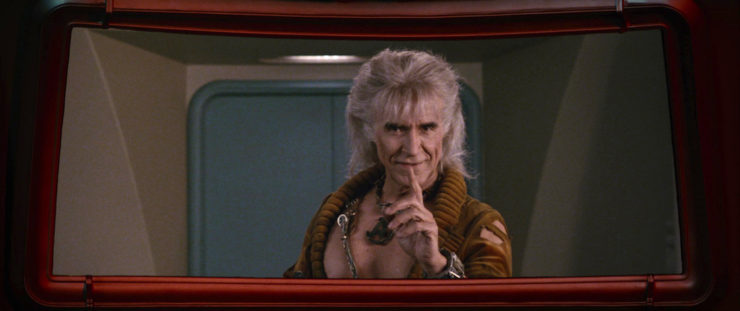
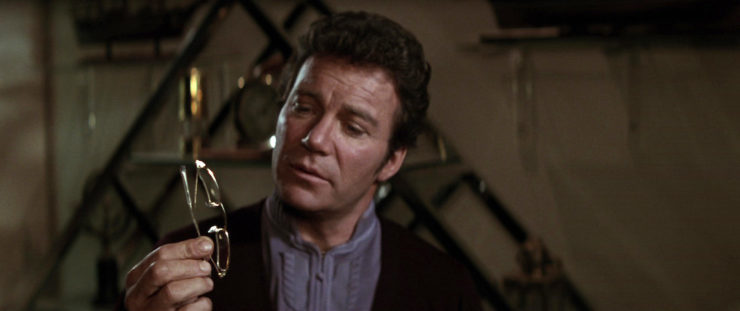

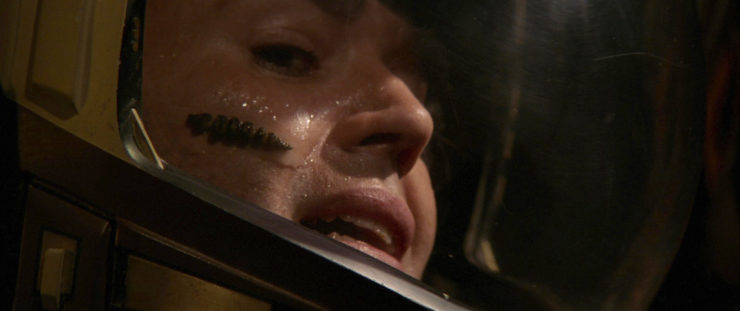
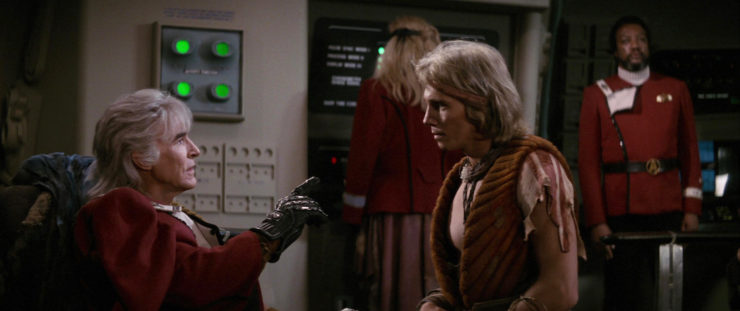
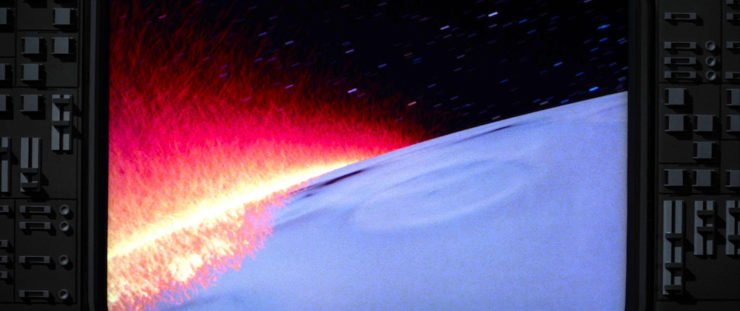
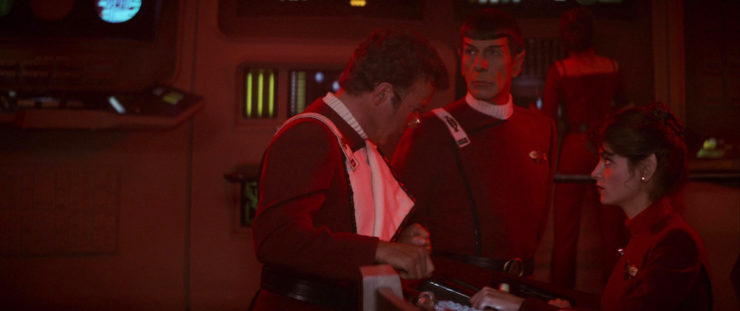
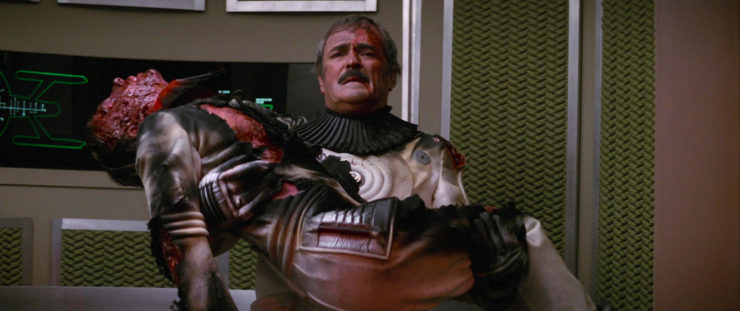
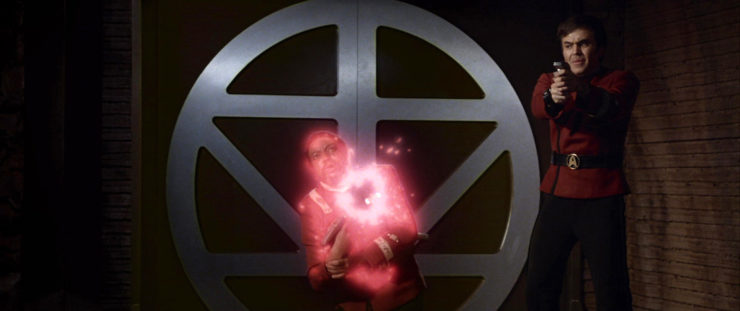
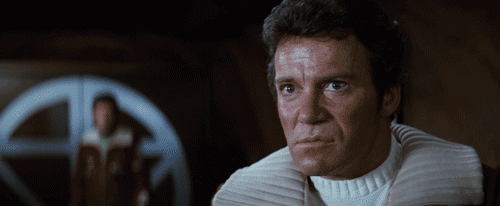
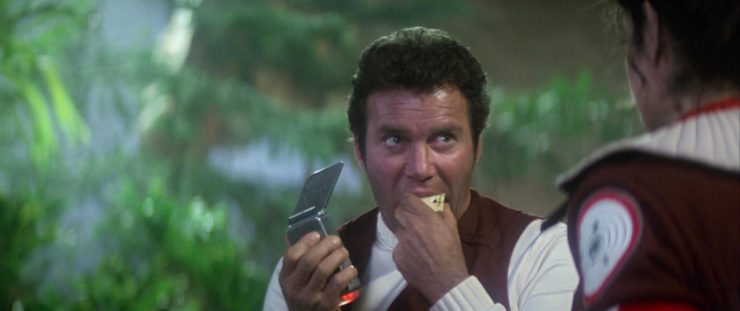
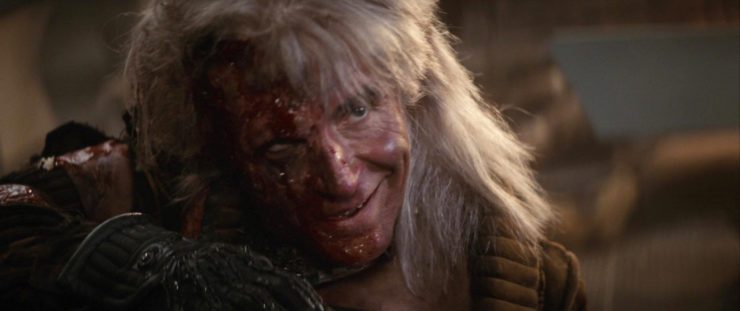
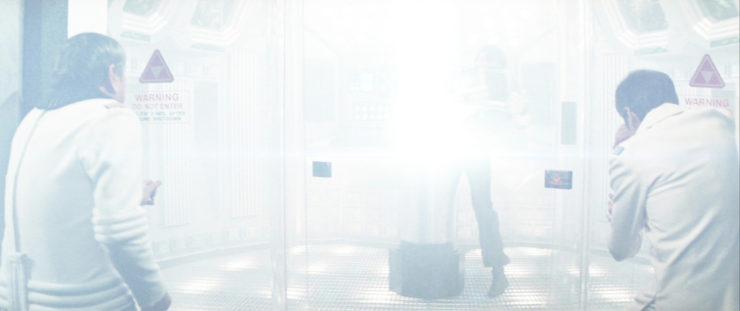
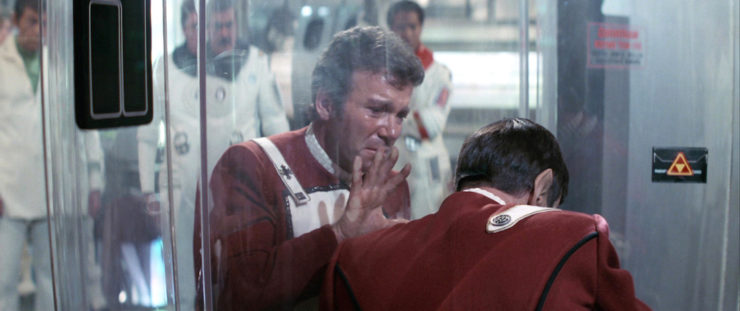
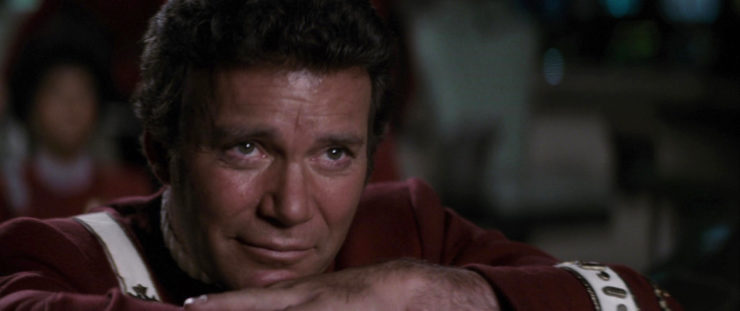
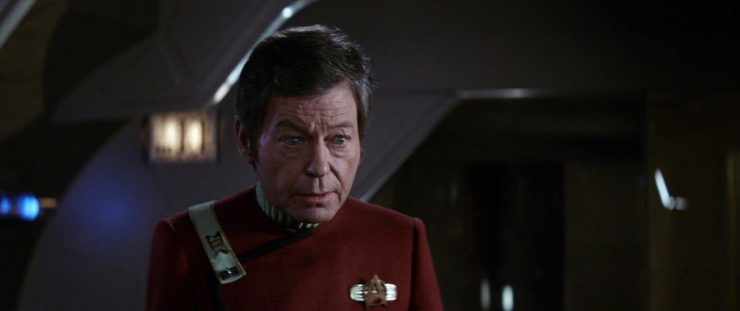
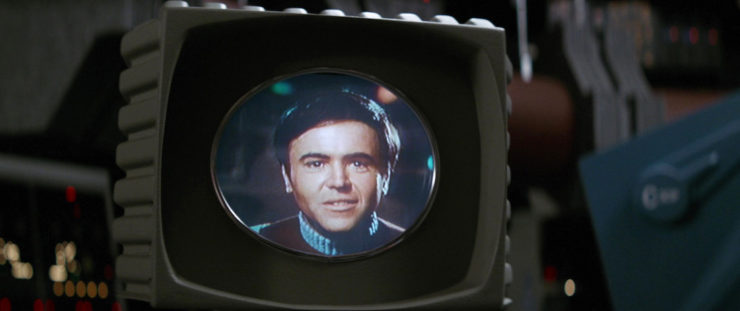
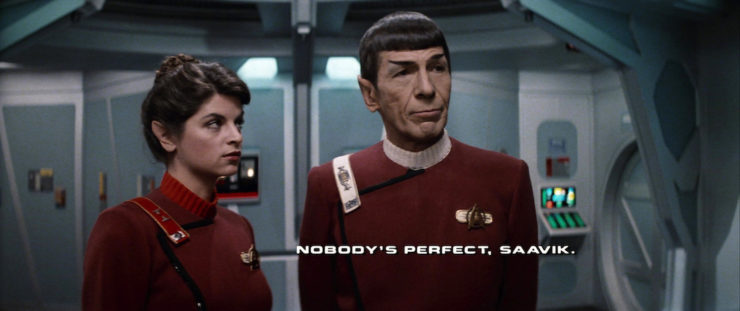

One minor thing that’s always bugged me — the Ceti Alpha V/VI mix-up. I assume that the planets are being numbered from the innermost outward (i.e. Mercury would be Sol I and Earth would be Sol III), so having planet VI blow up shouldn’t change the status of V as being the 5th planet outward from Ceti Alpha, unless VI blowing up really did a number on multiple planetary orbits or something.
But I’m willing to forgive that because it really is a great film, all other things considered.
According to Nicky Meyer, Bennett had to scramble to secure a director and script in order to meet ILM’s timeline and complete the visuals to finish a movie by the release date. The four screenplays Gene had commissioned were rejected and Meyer gleaned the four or five decent story clips he could from those scripts and strung them together. No wonder Gene was on the outside looking in. And its no doubt why Meyer didn’t get a screenplay credit- he really didn’t write much. The last 20 minutes is obviously pulled from “Balance of Terror”… it’s a WWII submarine movie.
“Saavik accuses him of never facing the test,”
I never liked this line. Kirk had been on two five year missions on the Enterprise, and literally every week had to win or die. Saavik, as a Starfleet cadet on the command track, would have studied Kirk’s (and other Captain’s) missions in depth. Her line is just silly.
I always assumed that the comment about the time travel loop with the glasses was a joke. So for a few centuries the glasses simply exist in two places
“Kirk says that of all the souls he’s met in his travels, Spock’s was the most human. Nice way to insult your best friend, Jim…”
Insult? Thats a compliment. I don’t think you get Spock at all.
I saw this one in the theaters. It wouldn’t have been a major moment at the time, true, but I don’t remember seeing the “Remember” line at the end in the original. I’ve always wondered if it was interpolated into the VHS and subsequent versions after the plans for Nimoy’s return in “Search for Spock” started to gel. Anybody know the story?
Vonda McIntyre’s novelization was extraordinarily well done, far above the usual standards of such works.
S
@1: There’s no reason to assume that Reliant or any other Federation vessel would approach a new star system from an angle that allows them to view all of the planets in the system simultaneously – if the system has been surveyed, then presumably the ship’s computer has accurate orbital positioning information on each planet. If CA V was supposed to be on the far side of Ceti Alpha when Reliant arrived, and the planet on which they landed was tolerably close to the predicted position of CA VI based on the system survey, there’s no reason for Reliant’s crew to suspect anything was up until it was too late. (This also assumes that V and VI were about the same size; a large difference in the size of the observed planet vs. survey records would probably tip someone off.)
Frankly, as long as a movie can stand on its own I don’t care that much about canon. Yes, blasphemy among Trekkies! So be it. As for the planetary mixup, I like to think it was a Neptune/Pluto orbital switch-a-roo situation, and the navigator aboard Reliant simply confused which planet had exploded. Yes, yes, a simplistic explanation that would have me burned at the stake with the NASA crowd, but that’s how I roll.
Worth it for Shatner and Montalban chewing every last bit of scenery. Space opera gotta opera!
The whole Ceti Alpha thing could have been fixed just by having the planet suffer some kind of planetary catastrophe like a supervolcano or an asteroid hit. Nuclear winter and all that would pretty much take care of things.
ragnarredbeard: I get him fine, thanks, I was being facetious and calling back to the (several) times on TOS when Kirk referred to Spock as acting human and Spock saying he sees no reason to be insulted…..
—Keith R.A. DeCandido